High Dependency Unit Nursing Case Study Analysis: Mr. Curtis
VerifiedAdded on 2023/01/04
|12
|3176
|79
Case Study
AI Summary
This assignment presents a comprehensive case study analysis of Mr. Curtis, a 74-year-old patient admitted to a healthcare facility for a cholecystectomy, who exhibited irregular heart rate, shortness of breath, and reduced oxygen saturation. The paper delves into three critical conditions: cardiac arrhythmia, respiratory acidosis, and systematic patient assessment. The analysis of cardiac arrhythmia includes an interpretation of an ECG, identifying atrial fibrillation, and discussing potential causes and treatment options such as antiarrhythmic medications, anticoagulants, and diuretics. The respiratory section examines the patient's symptoms and ABG results, diagnosing cardiogenic pulmonary edema and outlining appropriate interventions like oxygen therapy, diuretics, and nursing interventions focused on lung assessment and patient positioning. Finally, the assignment addresses systematic patient assessment, focusing on ABCDE assessment in both the HDU and ED settings, and the importance of patient handover reports to ensure continuity of care and patient safety. The assignment follows APA referencing style and provides detailed insights into the patient's condition and care plan.

Running head: HIGH DEPENDENCY UNIT
NURSING ASSIGNMENT (CASE STUDY ANALYSIS)
Name of the student
Name of the university
Author note
NURSING ASSIGNMENT (CASE STUDY ANALYSIS)
Name of the student
Name of the university
Author note
Paraphrase This Document
Need a fresh take? Get an instant paraphrase of this document with our AI Paraphraser
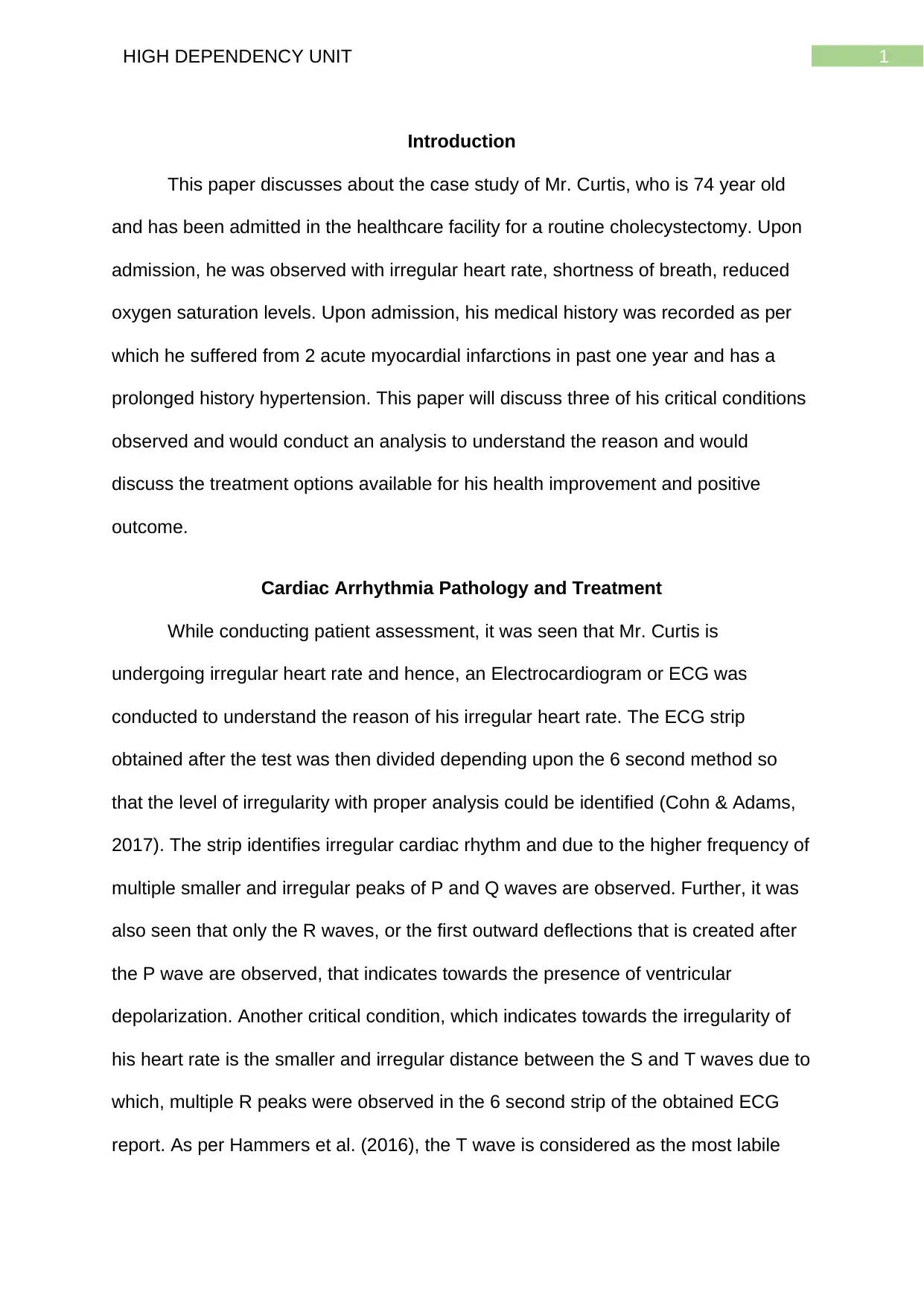
1HIGH DEPENDENCY UNIT
Introduction
This paper discusses about the case study of Mr. Curtis, who is 74 year old
and has been admitted in the healthcare facility for a routine cholecystectomy. Upon
admission, he was observed with irregular heart rate, shortness of breath, reduced
oxygen saturation levels. Upon admission, his medical history was recorded as per
which he suffered from 2 acute myocardial infarctions in past one year and has a
prolonged history hypertension. This paper will discuss three of his critical conditions
observed and would conduct an analysis to understand the reason and would
discuss the treatment options available for his health improvement and positive
outcome.
Cardiac Arrhythmia Pathology and Treatment
While conducting patient assessment, it was seen that Mr. Curtis is
undergoing irregular heart rate and hence, an Electrocardiogram or ECG was
conducted to understand the reason of his irregular heart rate. The ECG strip
obtained after the test was then divided depending upon the 6 second method so
that the level of irregularity with proper analysis could be identified (Cohn & Adams,
2017). The strip identifies irregular cardiac rhythm and due to the higher frequency of
multiple smaller and irregular peaks of P and Q waves are observed. Further, it was
also seen that only the R waves, or the first outward deflections that is created after
the P wave are observed, that indicates towards the presence of ventricular
depolarization. Another critical condition, which indicates towards the irregularity of
his heart rate is the smaller and irregular distance between the S and T waves due to
which, multiple R peaks were observed in the 6 second strip of the obtained ECG
report. As per Hammers et al. (2016), the T wave is considered as the most labile
Introduction
This paper discusses about the case study of Mr. Curtis, who is 74 year old
and has been admitted in the healthcare facility for a routine cholecystectomy. Upon
admission, he was observed with irregular heart rate, shortness of breath, reduced
oxygen saturation levels. Upon admission, his medical history was recorded as per
which he suffered from 2 acute myocardial infarctions in past one year and has a
prolonged history hypertension. This paper will discuss three of his critical conditions
observed and would conduct an analysis to understand the reason and would
discuss the treatment options available for his health improvement and positive
outcome.
Cardiac Arrhythmia Pathology and Treatment
While conducting patient assessment, it was seen that Mr. Curtis is
undergoing irregular heart rate and hence, an Electrocardiogram or ECG was
conducted to understand the reason of his irregular heart rate. The ECG strip
obtained after the test was then divided depending upon the 6 second method so
that the level of irregularity with proper analysis could be identified (Cohn & Adams,
2017). The strip identifies irregular cardiac rhythm and due to the higher frequency of
multiple smaller and irregular peaks of P and Q waves are observed. Further, it was
also seen that only the R waves, or the first outward deflections that is created after
the P wave are observed, that indicates towards the presence of ventricular
depolarization. Another critical condition, which indicates towards the irregularity of
his heart rate is the smaller and irregular distance between the S and T waves due to
which, multiple R peaks were observed in the 6 second strip of the obtained ECG
report. As per Hammers et al. (2016), the T wave is considered as the most labile

2HIGH DEPENDENCY UNIT
wave in the ECG strip as there are multiple reasons due to which an ECG report
could be seen as irregular as the T waves are inverted inside in irregular manner. As
per T waves are usually in the similar direction, however, in irregular conditions such
as higher risk of cardiac arrest or myocardial infarction, the T waves shows low
amplitude. Hence, this is one of the critical conditions that could be inferred from the
critical health condition. Further, it was also observed that the distance between the
S and T waves were irregular throughout the strip and hence, it could be inferred that
this irregular distance was caused by the presence of critical risk of myocardial
infarction. The peak of the R waves was smaller in few of the sections and as per
Verrier, Nearing, Olin, Boon and Schachter (2016), it could occur due to the lack or
weakening of the electrical activities of the associated cardiac muscles involved.
Further, Amino et al. (2017) also mentions that due to the risk of ST elevated
myocardial infarction, irregular ECG strips are obtained. Due to the risk of myocardial
infarction, the cardiac muscles suffers from injury and in this condition, depression in
the PR and ST segments are observed. Therefore, from this interpretation, it could
be observed that the patient is suffering from higher risk of ST elevated myocardial
infarction. Finally, calculating the heart rate using 6 second method also identified
the elevated blood pressure as there are total 17 peaks of R wave that indicates
towards a high blood pressure condition that may arise due to the risk of myocardial
infarction.
The treatment options that are available in this condition are associated with
Mr. Curtis’s irregular heart rate and risk of myocardial infarction should be inclusive
of the Antiarrhythmic medications. As he is suffering from Arterial fibrillation, he will
be provided with blood thinner or anticoagulants so that blood could flow properly
through his veins and reduces the risk of stroke. Further, in Antiarrhythmic drugs, he
wave in the ECG strip as there are multiple reasons due to which an ECG report
could be seen as irregular as the T waves are inverted inside in irregular manner. As
per T waves are usually in the similar direction, however, in irregular conditions such
as higher risk of cardiac arrest or myocardial infarction, the T waves shows low
amplitude. Hence, this is one of the critical conditions that could be inferred from the
critical health condition. Further, it was also observed that the distance between the
S and T waves were irregular throughout the strip and hence, it could be inferred that
this irregular distance was caused by the presence of critical risk of myocardial
infarction. The peak of the R waves was smaller in few of the sections and as per
Verrier, Nearing, Olin, Boon and Schachter (2016), it could occur due to the lack or
weakening of the electrical activities of the associated cardiac muscles involved.
Further, Amino et al. (2017) also mentions that due to the risk of ST elevated
myocardial infarction, irregular ECG strips are obtained. Due to the risk of myocardial
infarction, the cardiac muscles suffers from injury and in this condition, depression in
the PR and ST segments are observed. Therefore, from this interpretation, it could
be observed that the patient is suffering from higher risk of ST elevated myocardial
infarction. Finally, calculating the heart rate using 6 second method also identified
the elevated blood pressure as there are total 17 peaks of R wave that indicates
towards a high blood pressure condition that may arise due to the risk of myocardial
infarction.
The treatment options that are available in this condition are associated with
Mr. Curtis’s irregular heart rate and risk of myocardial infarction should be inclusive
of the Antiarrhythmic medications. As he is suffering from Arterial fibrillation, he will
be provided with blood thinner or anticoagulants so that blood could flow properly
through his veins and reduces the risk of stroke. Further, in Antiarrhythmic drugs, he
⊘ This is a preview!⊘
Do you want full access?
Subscribe today to unlock all pages.

Trusted by 1+ million students worldwide
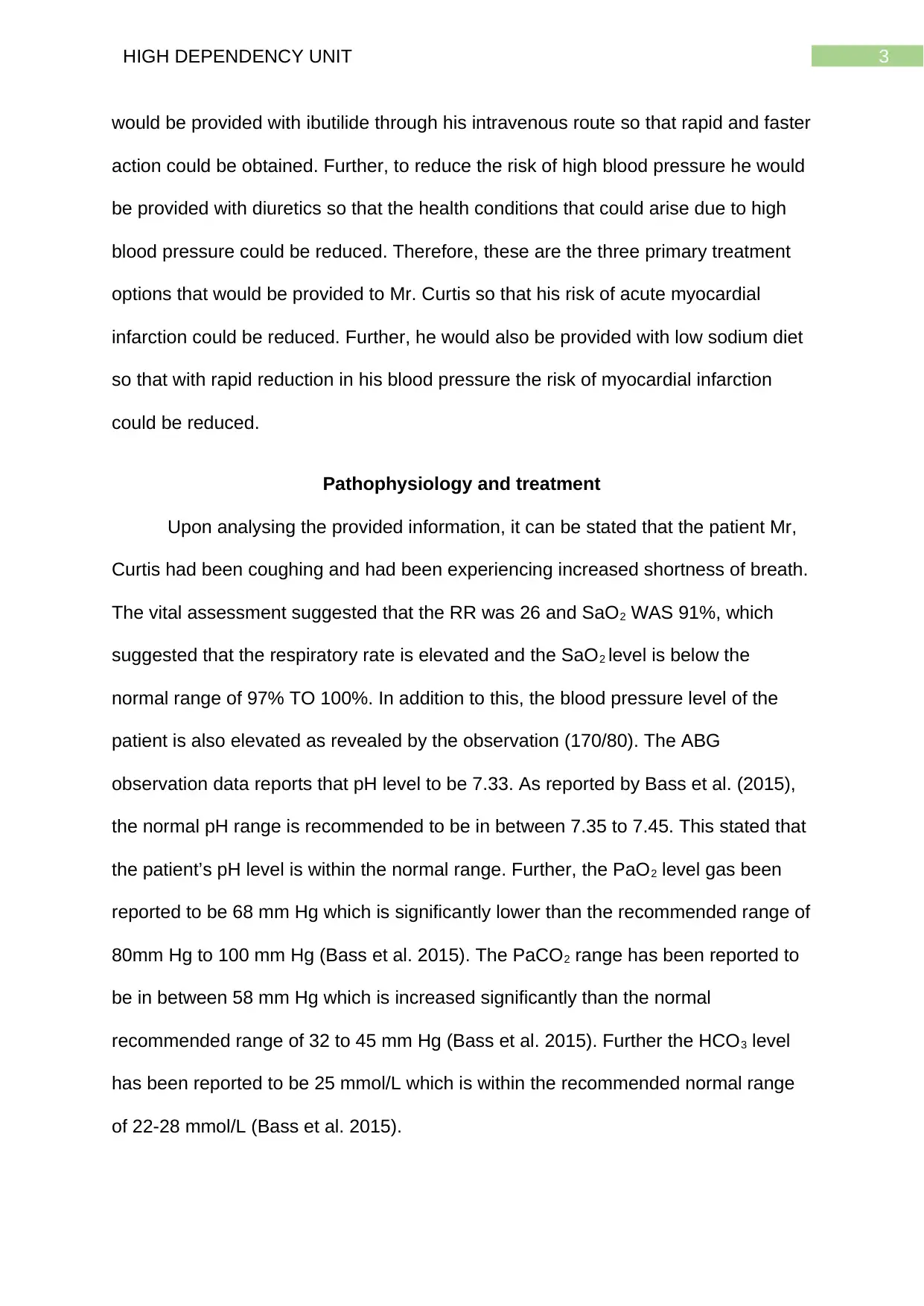
3HIGH DEPENDENCY UNIT
would be provided with ibutilide through his intravenous route so that rapid and faster
action could be obtained. Further, to reduce the risk of high blood pressure he would
be provided with diuretics so that the health conditions that could arise due to high
blood pressure could be reduced. Therefore, these are the three primary treatment
options that would be provided to Mr. Curtis so that his risk of acute myocardial
infarction could be reduced. Further, he would also be provided with low sodium diet
so that with rapid reduction in his blood pressure the risk of myocardial infarction
could be reduced.
Pathophysiology and treatment
Upon analysing the provided information, it can be stated that the patient Mr,
Curtis had been coughing and had been experiencing increased shortness of breath.
The vital assessment suggested that the RR was 26 and SaO2 WAS 91%, which
suggested that the respiratory rate is elevated and the SaO2 level is below the
normal range of 97% TO 100%. In addition to this, the blood pressure level of the
patient is also elevated as revealed by the observation (170/80). The ABG
observation data reports that pH level to be 7.33. As reported by Bass et al. (2015),
the normal pH range is recommended to be in between 7.35 to 7.45. This stated that
the patient’s pH level is within the normal range. Further, the PaO2 level gas been
reported to be 68 mm Hg which is significantly lower than the recommended range of
80mm Hg to 100 mm Hg (Bass et al. 2015). The PaCO2 range has been reported to
be in between 58 mm Hg which is increased significantly than the normal
recommended range of 32 to 45 mm Hg (Bass et al. 2015). Further the HCO3 level
has been reported to be 25 mmol/L which is within the recommended normal range
of 22-28 mmol/L (Bass et al. 2015).
would be provided with ibutilide through his intravenous route so that rapid and faster
action could be obtained. Further, to reduce the risk of high blood pressure he would
be provided with diuretics so that the health conditions that could arise due to high
blood pressure could be reduced. Therefore, these are the three primary treatment
options that would be provided to Mr. Curtis so that his risk of acute myocardial
infarction could be reduced. Further, he would also be provided with low sodium diet
so that with rapid reduction in his blood pressure the risk of myocardial infarction
could be reduced.
Pathophysiology and treatment
Upon analysing the provided information, it can be stated that the patient Mr,
Curtis had been coughing and had been experiencing increased shortness of breath.
The vital assessment suggested that the RR was 26 and SaO2 WAS 91%, which
suggested that the respiratory rate is elevated and the SaO2 level is below the
normal range of 97% TO 100%. In addition to this, the blood pressure level of the
patient is also elevated as revealed by the observation (170/80). The ABG
observation data reports that pH level to be 7.33. As reported by Bass et al. (2015),
the normal pH range is recommended to be in between 7.35 to 7.45. This stated that
the patient’s pH level is within the normal range. Further, the PaO2 level gas been
reported to be 68 mm Hg which is significantly lower than the recommended range of
80mm Hg to 100 mm Hg (Bass et al. 2015). The PaCO2 range has been reported to
be in between 58 mm Hg which is increased significantly than the normal
recommended range of 32 to 45 mm Hg (Bass et al. 2015). Further the HCO3 level
has been reported to be 25 mmol/L which is within the recommended normal range
of 22-28 mmol/L (Bass et al. 2015).
Paraphrase This Document
Need a fresh take? Get an instant paraphrase of this document with our AI Paraphraser
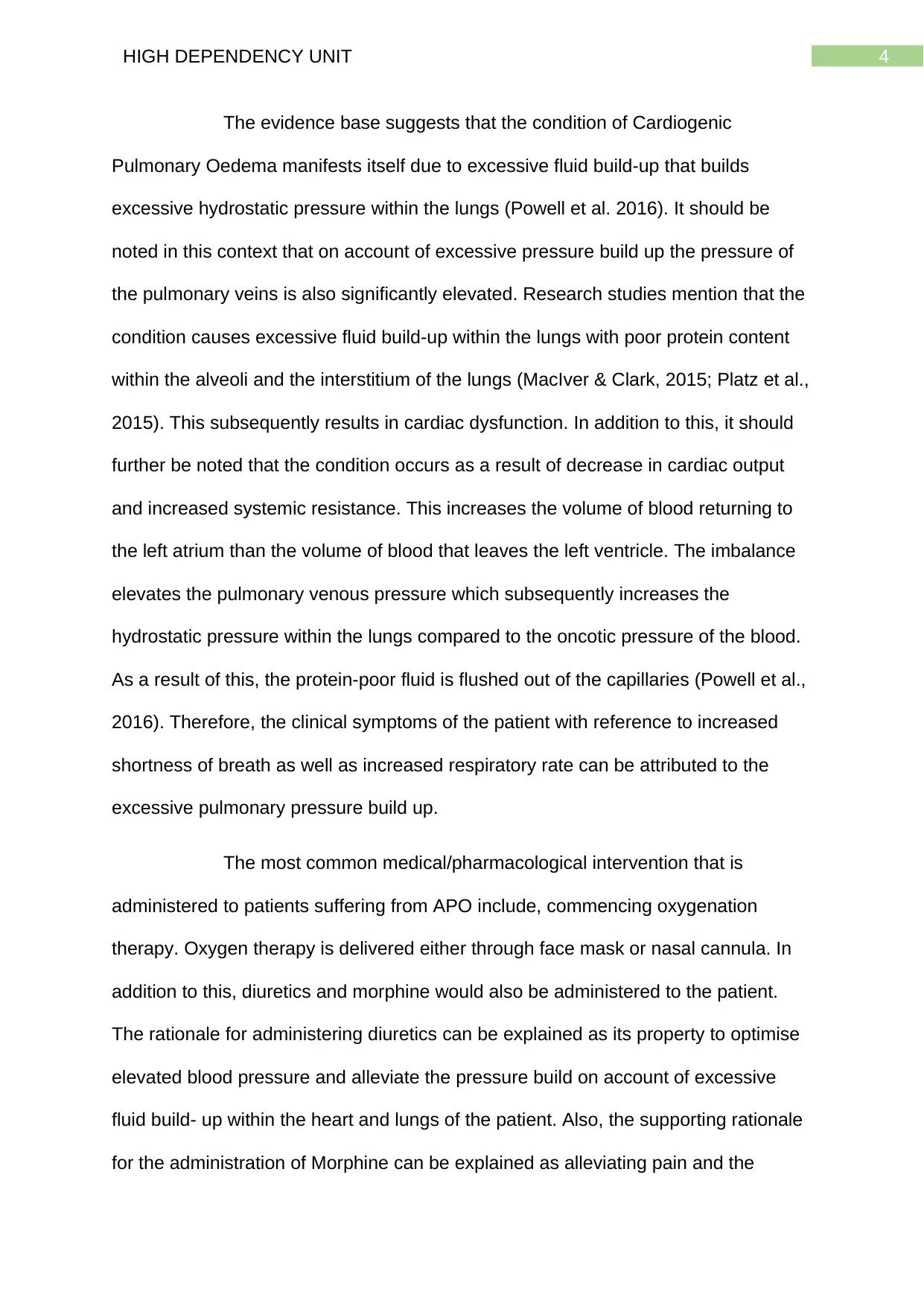
4HIGH DEPENDENCY UNIT
The evidence base suggests that the condition of Cardiogenic
Pulmonary Oedema manifests itself due to excessive fluid build-up that builds
excessive hydrostatic pressure within the lungs (Powell et al. 2016). It should be
noted in this context that on account of excessive pressure build up the pressure of
the pulmonary veins is also significantly elevated. Research studies mention that the
condition causes excessive fluid build-up within the lungs with poor protein content
within the alveoli and the interstitium of the lungs (MacIver & Clark, 2015; Platz et al.,
2015). This subsequently results in cardiac dysfunction. In addition to this, it should
further be noted that the condition occurs as a result of decrease in cardiac output
and increased systemic resistance. This increases the volume of blood returning to
the left atrium than the volume of blood that leaves the left ventricle. The imbalance
elevates the pulmonary venous pressure which subsequently increases the
hydrostatic pressure within the lungs compared to the oncotic pressure of the blood.
As a result of this, the protein-poor fluid is flushed out of the capillaries (Powell et al.,
2016). Therefore, the clinical symptoms of the patient with reference to increased
shortness of breath as well as increased respiratory rate can be attributed to the
excessive pulmonary pressure build up.
The most common medical/pharmacological intervention that is
administered to patients suffering from APO include, commencing oxygenation
therapy. Oxygen therapy is delivered either through face mask or nasal cannula. In
addition to this, diuretics and morphine would also be administered to the patient.
The rationale for administering diuretics can be explained as its property to optimise
elevated blood pressure and alleviate the pressure build on account of excessive
fluid build- up within the heart and lungs of the patient. Also, the supporting rationale
for the administration of Morphine can be explained as alleviating pain and the
The evidence base suggests that the condition of Cardiogenic
Pulmonary Oedema manifests itself due to excessive fluid build-up that builds
excessive hydrostatic pressure within the lungs (Powell et al. 2016). It should be
noted in this context that on account of excessive pressure build up the pressure of
the pulmonary veins is also significantly elevated. Research studies mention that the
condition causes excessive fluid build-up within the lungs with poor protein content
within the alveoli and the interstitium of the lungs (MacIver & Clark, 2015; Platz et al.,
2015). This subsequently results in cardiac dysfunction. In addition to this, it should
further be noted that the condition occurs as a result of decrease in cardiac output
and increased systemic resistance. This increases the volume of blood returning to
the left atrium than the volume of blood that leaves the left ventricle. The imbalance
elevates the pulmonary venous pressure which subsequently increases the
hydrostatic pressure within the lungs compared to the oncotic pressure of the blood.
As a result of this, the protein-poor fluid is flushed out of the capillaries (Powell et al.,
2016). Therefore, the clinical symptoms of the patient with reference to increased
shortness of breath as well as increased respiratory rate can be attributed to the
excessive pulmonary pressure build up.
The most common medical/pharmacological intervention that is
administered to patients suffering from APO include, commencing oxygenation
therapy. Oxygen therapy is delivered either through face mask or nasal cannula. In
addition to this, diuretics and morphine would also be administered to the patient.
The rationale for administering diuretics can be explained as its property to optimise
elevated blood pressure and alleviate the pressure build on account of excessive
fluid build- up within the heart and lungs of the patient. Also, the supporting rationale
for the administration of Morphine can be explained as alleviating pain and the
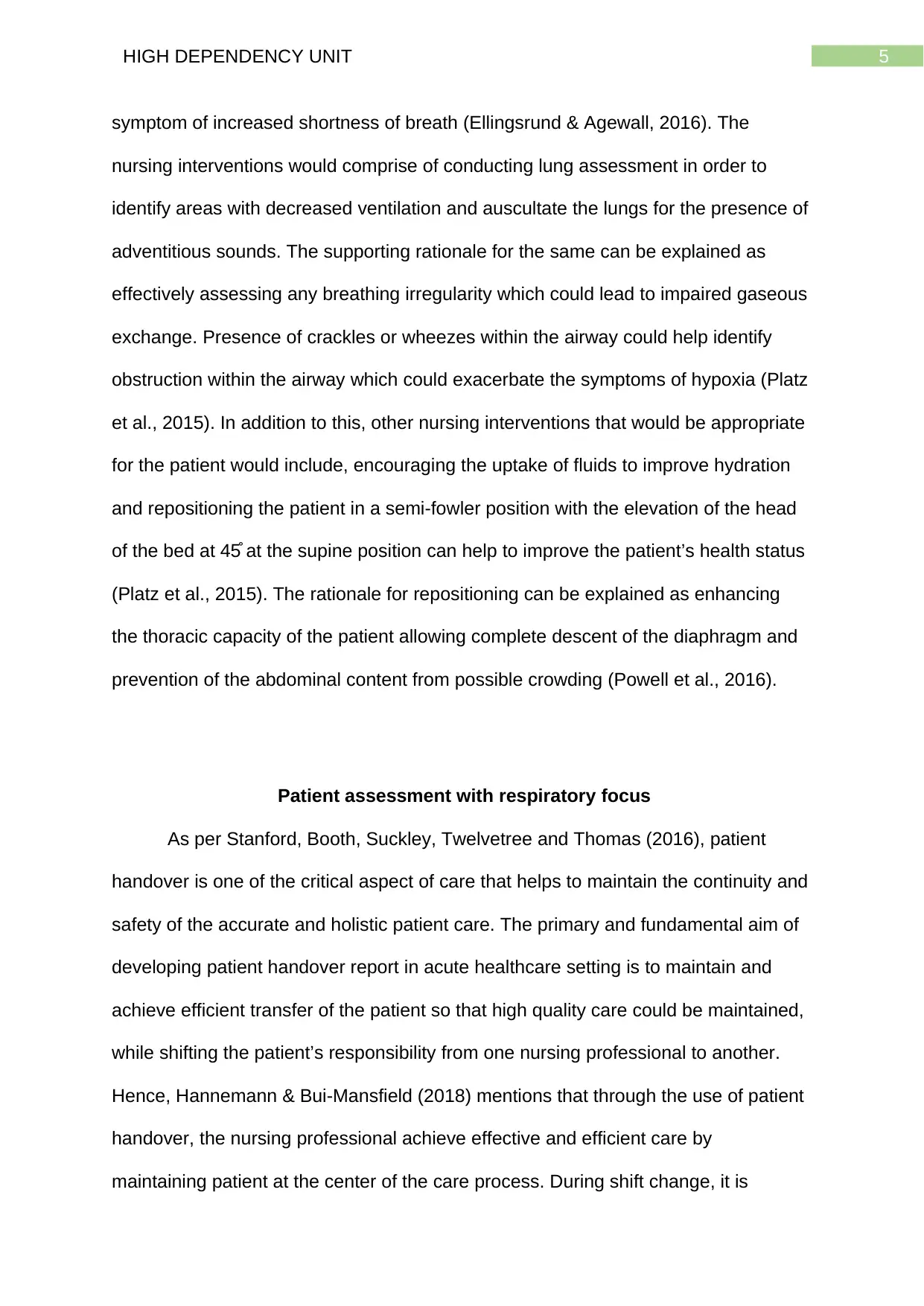
5HIGH DEPENDENCY UNIT
symptom of increased shortness of breath (Ellingsrund & Agewall, 2016). The
nursing interventions would comprise of conducting lung assessment in order to
identify areas with decreased ventilation and auscultate the lungs for the presence of
adventitious sounds. The supporting rationale for the same can be explained as
effectively assessing any breathing irregularity which could lead to impaired gaseous
exchange. Presence of crackles or wheezes within the airway could help identify
obstruction within the airway which could exacerbate the symptoms of hypoxia (Platz
et al., 2015). In addition to this, other nursing interventions that would be appropriate
for the patient would include, encouraging the uptake of fluids to improve hydration
and repositioning the patient in a semi-fowler position with the elevation of the head
of the bed at 45̊ at the supine position can help to improve the patient’s health status
(Platz et al., 2015). The rationale for repositioning can be explained as enhancing
the thoracic capacity of the patient allowing complete descent of the diaphragm and
prevention of the abdominal content from possible crowding (Powell et al., 2016).
Patient assessment with respiratory focus
As per Stanford, Booth, Suckley, Twelvetree and Thomas (2016), patient
handover is one of the critical aspect of care that helps to maintain the continuity and
safety of the accurate and holistic patient care. The primary and fundamental aim of
developing patient handover report in acute healthcare setting is to maintain and
achieve efficient transfer of the patient so that high quality care could be maintained,
while shifting the patient’s responsibility from one nursing professional to another.
Hence, Hannemann & Bui-Mansfield (2018) mentions that through the use of patient
handover, the nursing professional achieve effective and efficient care by
maintaining patient at the center of the care process. During shift change, it is
symptom of increased shortness of breath (Ellingsrund & Agewall, 2016). The
nursing interventions would comprise of conducting lung assessment in order to
identify areas with decreased ventilation and auscultate the lungs for the presence of
adventitious sounds. The supporting rationale for the same can be explained as
effectively assessing any breathing irregularity which could lead to impaired gaseous
exchange. Presence of crackles or wheezes within the airway could help identify
obstruction within the airway which could exacerbate the symptoms of hypoxia (Platz
et al., 2015). In addition to this, other nursing interventions that would be appropriate
for the patient would include, encouraging the uptake of fluids to improve hydration
and repositioning the patient in a semi-fowler position with the elevation of the head
of the bed at 45̊ at the supine position can help to improve the patient’s health status
(Platz et al., 2015). The rationale for repositioning can be explained as enhancing
the thoracic capacity of the patient allowing complete descent of the diaphragm and
prevention of the abdominal content from possible crowding (Powell et al., 2016).
Patient assessment with respiratory focus
As per Stanford, Booth, Suckley, Twelvetree and Thomas (2016), patient
handover is one of the critical aspect of care that helps to maintain the continuity and
safety of the accurate and holistic patient care. The primary and fundamental aim of
developing patient handover report in acute healthcare setting is to maintain and
achieve efficient transfer of the patient so that high quality care could be maintained,
while shifting the patient’s responsibility from one nursing professional to another.
Hence, Hannemann & Bui-Mansfield (2018) mentions that through the use of patient
handover, the nursing professional achieve effective and efficient care by
maintaining patient at the center of the care process. During shift change, it is
⊘ This is a preview!⊘
Do you want full access?
Subscribe today to unlock all pages.

Trusted by 1+ million students worldwide
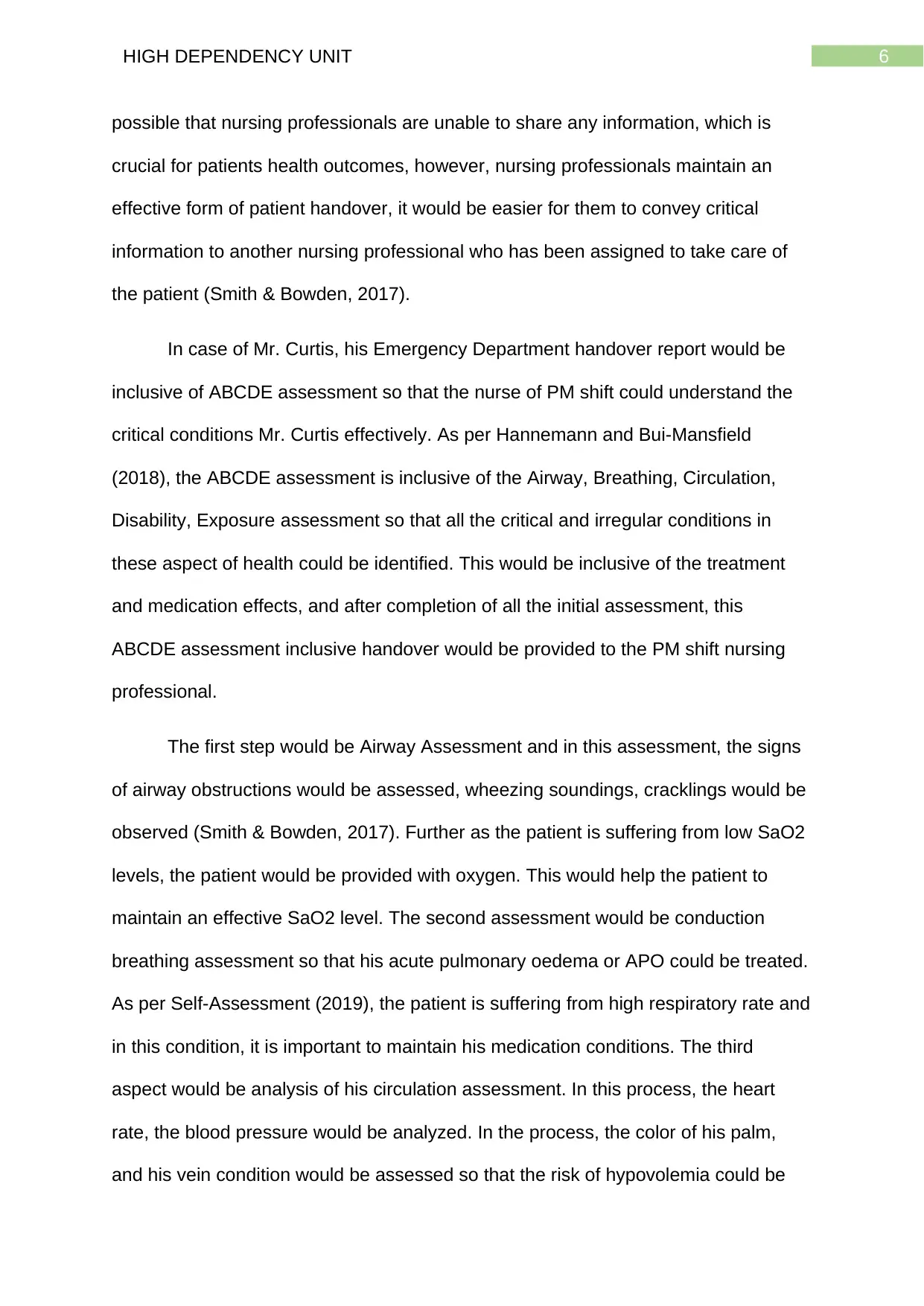
6HIGH DEPENDENCY UNIT
possible that nursing professionals are unable to share any information, which is
crucial for patients health outcomes, however, nursing professionals maintain an
effective form of patient handover, it would be easier for them to convey critical
information to another nursing professional who has been assigned to take care of
the patient (Smith & Bowden, 2017).
In case of Mr. Curtis, his Emergency Department handover report would be
inclusive of ABCDE assessment so that the nurse of PM shift could understand the
critical conditions Mr. Curtis effectively. As per Hannemann and Bui-Mansfield
(2018), the ABCDE assessment is inclusive of the Airway, Breathing, Circulation,
Disability, Exposure assessment so that all the critical and irregular conditions in
these aspect of health could be identified. This would be inclusive of the treatment
and medication effects, and after completion of all the initial assessment, this
ABCDE assessment inclusive handover would be provided to the PM shift nursing
professional.
The first step would be Airway Assessment and in this assessment, the signs
of airway obstructions would be assessed, wheezing soundings, cracklings would be
observed (Smith & Bowden, 2017). Further as the patient is suffering from low SaO2
levels, the patient would be provided with oxygen. This would help the patient to
maintain an effective SaO2 level. The second assessment would be conduction
breathing assessment so that his acute pulmonary oedema or APO could be treated.
As per Self-Assessment (2019), the patient is suffering from high respiratory rate and
in this condition, it is important to maintain his medication conditions. The third
aspect would be analysis of his circulation assessment. In this process, the heart
rate, the blood pressure would be analyzed. In the process, the color of his palm,
and his vein condition would be assessed so that the risk of hypovolemia could be
possible that nursing professionals are unable to share any information, which is
crucial for patients health outcomes, however, nursing professionals maintain an
effective form of patient handover, it would be easier for them to convey critical
information to another nursing professional who has been assigned to take care of
the patient (Smith & Bowden, 2017).
In case of Mr. Curtis, his Emergency Department handover report would be
inclusive of ABCDE assessment so that the nurse of PM shift could understand the
critical conditions Mr. Curtis effectively. As per Hannemann and Bui-Mansfield
(2018), the ABCDE assessment is inclusive of the Airway, Breathing, Circulation,
Disability, Exposure assessment so that all the critical and irregular conditions in
these aspect of health could be identified. This would be inclusive of the treatment
and medication effects, and after completion of all the initial assessment, this
ABCDE assessment inclusive handover would be provided to the PM shift nursing
professional.
The first step would be Airway Assessment and in this assessment, the signs
of airway obstructions would be assessed, wheezing soundings, cracklings would be
observed (Smith & Bowden, 2017). Further as the patient is suffering from low SaO2
levels, the patient would be provided with oxygen. This would help the patient to
maintain an effective SaO2 level. The second assessment would be conduction
breathing assessment so that his acute pulmonary oedema or APO could be treated.
As per Self-Assessment (2019), the patient is suffering from high respiratory rate and
in this condition, it is important to maintain his medication conditions. The third
aspect would be analysis of his circulation assessment. In this process, the heart
rate, the blood pressure would be analyzed. In the process, the color of his palm,
and his vein condition would be assessed so that the risk of hypovolemia could be
Paraphrase This Document
Need a fresh take? Get an instant paraphrase of this document with our AI Paraphraser

7HIGH DEPENDENCY UNIT
assessed. The fourth aspect would be analysis of his disability and in this aspect, the
patient’s hypoxia, cerebral hypo-perfusion and the dosage pf the sedatives and
analgesics would be analyzed so that the consciousness of the patient could be
analyzed. The final aspect would be analysis of exposure so that all the needs of the
patient could be provided. This is an important aspect that helps the healthcare
professionals to identify that patient’s dignity and respect is maintained carefully in
the care process. Hence, through this ABCDE assessment each aspect of the
patient’s physical and mental condition would be conveyed to the PM Nurse so that
holistic care could be continued (Self-Assessment, 2019).
While analyzing the three critical signs and symptoms of APO, the occurrence
of gasping of breath, shortness of breath and anxiety and restlessness should be
discussed. As per Schmidt et al. (2019), when the heart is unable to pump enough
blood efficiently to the body, then the blood pressure increases and results into the
transfer of blood into the air spaces. Due to this accumulation the fluid accumulation
occurs that reduces the normal flow of oxygen in the patient’s body. Hence, the
patient suffers from the risk of shortness of breath and anxiety (Brij, Bambrough &
Vijayasankar, 2016). Further, due to excessive fluid accumulated in the lungs, the
patient may suffer from wheezing sounds of lungs.
Conclusion
While concluding this paper, it could be mentioned that the Mr. Curtis was
admitted to the healthcare facility after his critical health condition associated with his
risk of myocardial infarction and acute pulmonary oedema. In this aspect, this paper
discusses about his critical heart rate, his resulting APO and the pathophysiology
associated with it. Further, the patient handover report developed for the patient
handover has been discussed in this paper.
assessed. The fourth aspect would be analysis of his disability and in this aspect, the
patient’s hypoxia, cerebral hypo-perfusion and the dosage pf the sedatives and
analgesics would be analyzed so that the consciousness of the patient could be
analyzed. The final aspect would be analysis of exposure so that all the needs of the
patient could be provided. This is an important aspect that helps the healthcare
professionals to identify that patient’s dignity and respect is maintained carefully in
the care process. Hence, through this ABCDE assessment each aspect of the
patient’s physical and mental condition would be conveyed to the PM Nurse so that
holistic care could be continued (Self-Assessment, 2019).
While analyzing the three critical signs and symptoms of APO, the occurrence
of gasping of breath, shortness of breath and anxiety and restlessness should be
discussed. As per Schmidt et al. (2019), when the heart is unable to pump enough
blood efficiently to the body, then the blood pressure increases and results into the
transfer of blood into the air spaces. Due to this accumulation the fluid accumulation
occurs that reduces the normal flow of oxygen in the patient’s body. Hence, the
patient suffers from the risk of shortness of breath and anxiety (Brij, Bambrough &
Vijayasankar, 2016). Further, due to excessive fluid accumulated in the lungs, the
patient may suffer from wheezing sounds of lungs.
Conclusion
While concluding this paper, it could be mentioned that the Mr. Curtis was
admitted to the healthcare facility after his critical health condition associated with his
risk of myocardial infarction and acute pulmonary oedema. In this aspect, this paper
discusses about his critical heart rate, his resulting APO and the pathophysiology
associated with it. Further, the patient handover report developed for the patient
handover has been discussed in this paper.

8HIGH DEPENDENCY UNIT
⊘ This is a preview!⊘
Do you want full access?
Subscribe today to unlock all pages.

Trusted by 1+ million students worldwide
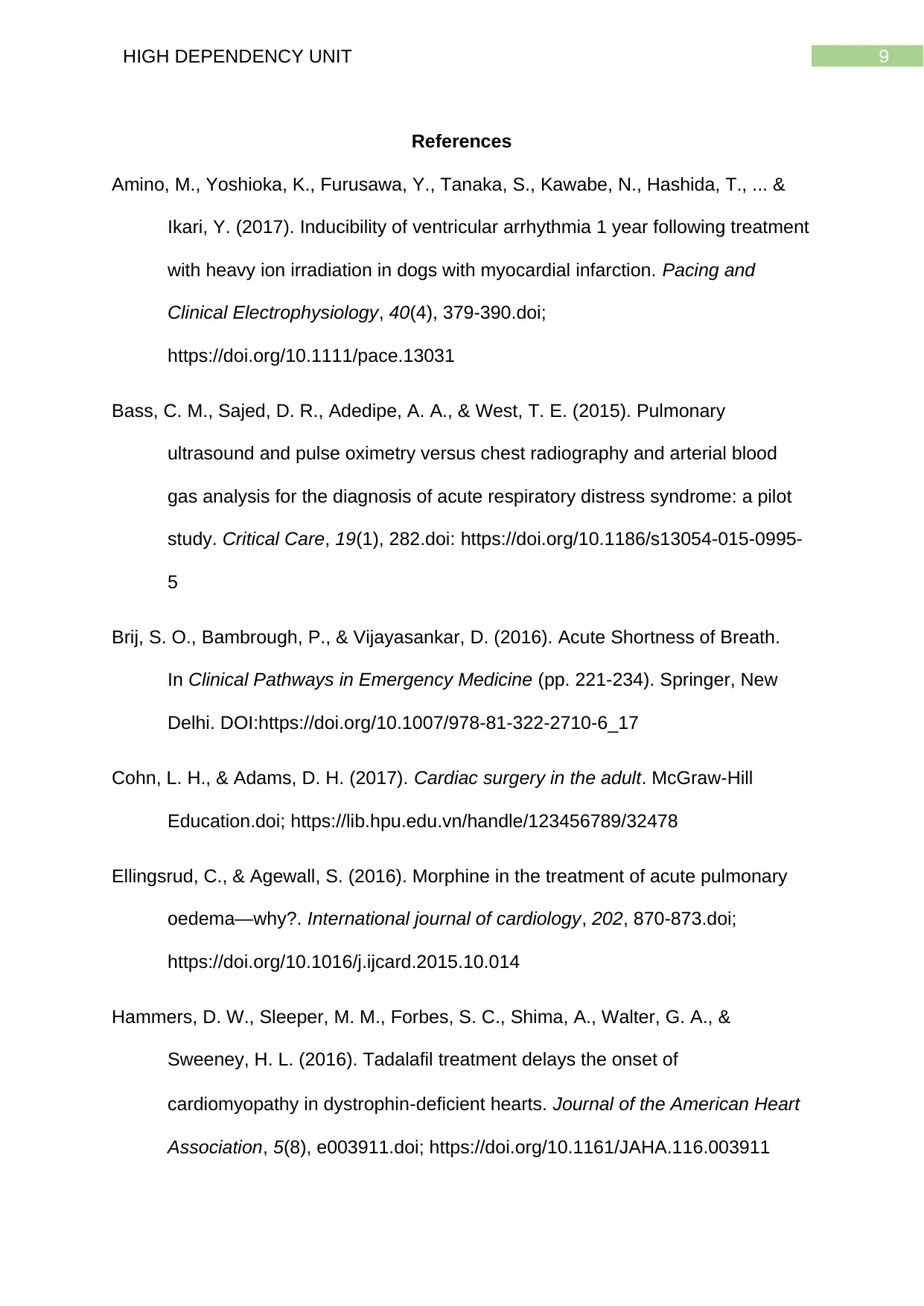
9HIGH DEPENDENCY UNIT
References
Amino, M., Yoshioka, K., Furusawa, Y., Tanaka, S., Kawabe, N., Hashida, T., ... &
Ikari, Y. (2017). Inducibility of ventricular arrhythmia 1 year following treatment
with heavy ion irradiation in dogs with myocardial infarction. Pacing and
Clinical Electrophysiology, 40(4), 379-390.doi;
https://doi.org/10.1111/pace.13031
Bass, C. M., Sajed, D. R., Adedipe, A. A., & West, T. E. (2015). Pulmonary
ultrasound and pulse oximetry versus chest radiography and arterial blood
gas analysis for the diagnosis of acute respiratory distress syndrome: a pilot
study. Critical Care, 19(1), 282.doi: https://doi.org/10.1186/s13054-015-0995-
5
Brij, S. O., Bambrough, P., & Vijayasankar, D. (2016). Acute Shortness of Breath.
In Clinical Pathways in Emergency Medicine (pp. 221-234). Springer, New
Delhi. DOI:https://doi.org/10.1007/978-81-322-2710-6_17
Cohn, L. H., & Adams, D. H. (2017). Cardiac surgery in the adult. McGraw-Hill
Education.doi; https://lib.hpu.edu.vn/handle/123456789/32478
Ellingsrud, C., & Agewall, S. (2016). Morphine in the treatment of acute pulmonary
oedema—why?. International journal of cardiology, 202, 870-873.doi;
https://doi.org/10.1016/j.ijcard.2015.10.014
Hammers, D. W., Sleeper, M. M., Forbes, S. C., Shima, A., Walter, G. A., &
Sweeney, H. L. (2016). Tadalafil treatment delays the onset of
cardiomyopathy in dystrophin‐deficient hearts. Journal of the American Heart
Association, 5(8), e003911.doi; https://doi.org/10.1161/JAHA.116.003911
References
Amino, M., Yoshioka, K., Furusawa, Y., Tanaka, S., Kawabe, N., Hashida, T., ... &
Ikari, Y. (2017). Inducibility of ventricular arrhythmia 1 year following treatment
with heavy ion irradiation in dogs with myocardial infarction. Pacing and
Clinical Electrophysiology, 40(4), 379-390.doi;
https://doi.org/10.1111/pace.13031
Bass, C. M., Sajed, D. R., Adedipe, A. A., & West, T. E. (2015). Pulmonary
ultrasound and pulse oximetry versus chest radiography and arterial blood
gas analysis for the diagnosis of acute respiratory distress syndrome: a pilot
study. Critical Care, 19(1), 282.doi: https://doi.org/10.1186/s13054-015-0995-
5
Brij, S. O., Bambrough, P., & Vijayasankar, D. (2016). Acute Shortness of Breath.
In Clinical Pathways in Emergency Medicine (pp. 221-234). Springer, New
Delhi. DOI:https://doi.org/10.1007/978-81-322-2710-6_17
Cohn, L. H., & Adams, D. H. (2017). Cardiac surgery in the adult. McGraw-Hill
Education.doi; https://lib.hpu.edu.vn/handle/123456789/32478
Ellingsrud, C., & Agewall, S. (2016). Morphine in the treatment of acute pulmonary
oedema—why?. International journal of cardiology, 202, 870-873.doi;
https://doi.org/10.1016/j.ijcard.2015.10.014
Hammers, D. W., Sleeper, M. M., Forbes, S. C., Shima, A., Walter, G. A., &
Sweeney, H. L. (2016). Tadalafil treatment delays the onset of
cardiomyopathy in dystrophin‐deficient hearts. Journal of the American Heart
Association, 5(8), e003911.doi; https://doi.org/10.1161/JAHA.116.003911
Paraphrase This Document
Need a fresh take? Get an instant paraphrase of this document with our AI Paraphraser
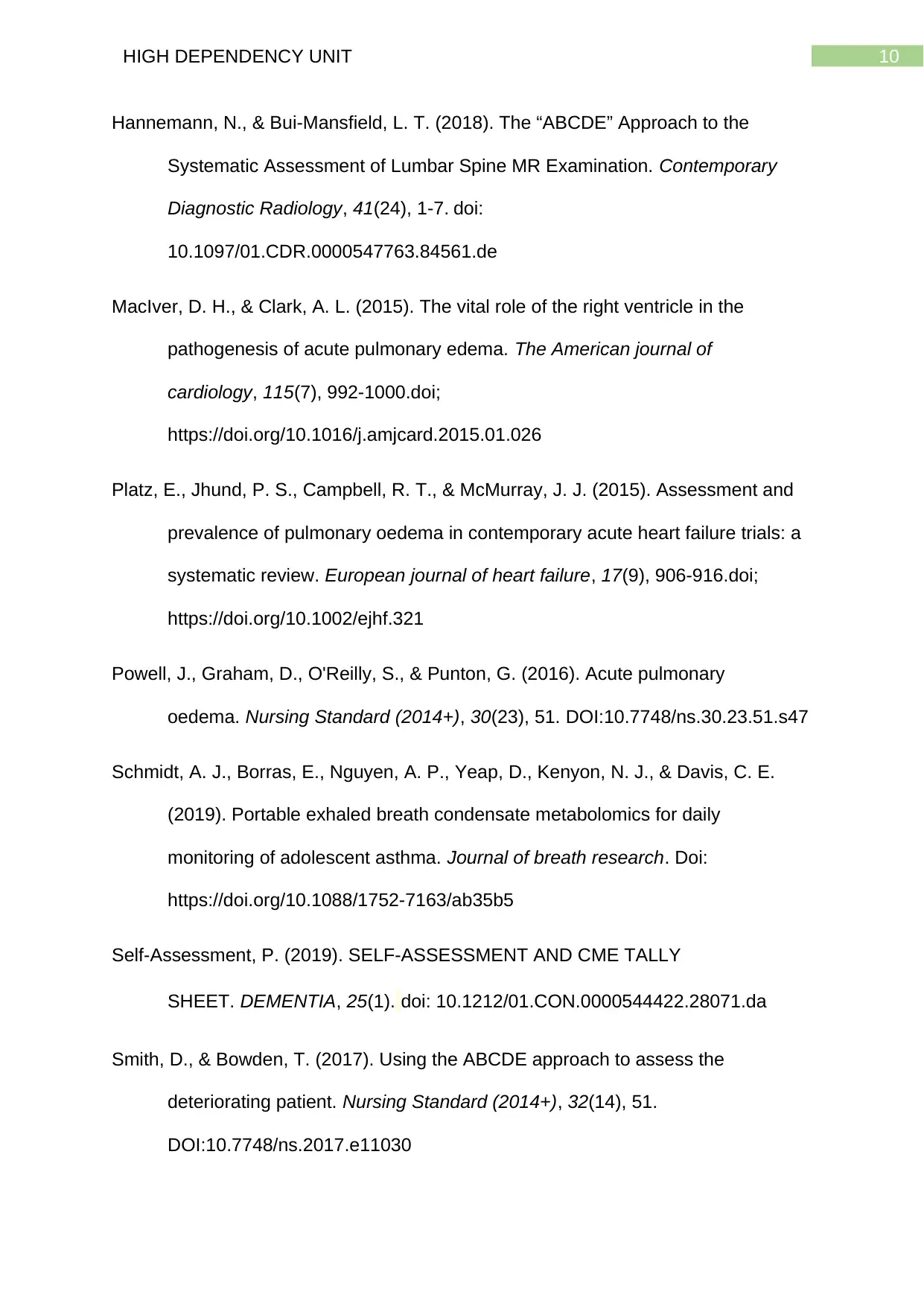
10HIGH DEPENDENCY UNIT
Hannemann, N., & Bui-Mansfield, L. T. (2018). The “ABCDE” Approach to the
Systematic Assessment of Lumbar Spine MR Examination. Contemporary
Diagnostic Radiology, 41(24), 1-7. doi:
10.1097/01.CDR.0000547763.84561.de
MacIver, D. H., & Clark, A. L. (2015). The vital role of the right ventricle in the
pathogenesis of acute pulmonary edema. The American journal of
cardiology, 115(7), 992-1000.doi;
https://doi.org/10.1016/j.amjcard.2015.01.026
Platz, E., Jhund, P. S., Campbell, R. T., & McMurray, J. J. (2015). Assessment and
prevalence of pulmonary oedema in contemporary acute heart failure trials: a
systematic review. European journal of heart failure, 17(9), 906-916.doi;
https://doi.org/10.1002/ejhf.321
Powell, J., Graham, D., O'Reilly, S., & Punton, G. (2016). Acute pulmonary
oedema. Nursing Standard (2014+), 30(23), 51. DOI:10.7748/ns.30.23.51.s47
Schmidt, A. J., Borras, E., Nguyen, A. P., Yeap, D., Kenyon, N. J., & Davis, C. E.
(2019). Portable exhaled breath condensate metabolomics for daily
monitoring of adolescent asthma. Journal of breath research. Doi:
https://doi.org/10.1088/1752-7163/ab35b5
Self-Assessment, P. (2019). SELF-ASSESSMENT AND CME TALLY
SHEET. DEMENTIA, 25(1). doi: 10.1212/01.CON.0000544422.28071.da
Smith, D., & Bowden, T. (2017). Using the ABCDE approach to assess the
deteriorating patient. Nursing Standard (2014+), 32(14), 51.
DOI:10.7748/ns.2017.e11030
Hannemann, N., & Bui-Mansfield, L. T. (2018). The “ABCDE” Approach to the
Systematic Assessment of Lumbar Spine MR Examination. Contemporary
Diagnostic Radiology, 41(24), 1-7. doi:
10.1097/01.CDR.0000547763.84561.de
MacIver, D. H., & Clark, A. L. (2015). The vital role of the right ventricle in the
pathogenesis of acute pulmonary edema. The American journal of
cardiology, 115(7), 992-1000.doi;
https://doi.org/10.1016/j.amjcard.2015.01.026
Platz, E., Jhund, P. S., Campbell, R. T., & McMurray, J. J. (2015). Assessment and
prevalence of pulmonary oedema in contemporary acute heart failure trials: a
systematic review. European journal of heart failure, 17(9), 906-916.doi;
https://doi.org/10.1002/ejhf.321
Powell, J., Graham, D., O'Reilly, S., & Punton, G. (2016). Acute pulmonary
oedema. Nursing Standard (2014+), 30(23), 51. DOI:10.7748/ns.30.23.51.s47
Schmidt, A. J., Borras, E., Nguyen, A. P., Yeap, D., Kenyon, N. J., & Davis, C. E.
(2019). Portable exhaled breath condensate metabolomics for daily
monitoring of adolescent asthma. Journal of breath research. Doi:
https://doi.org/10.1088/1752-7163/ab35b5
Self-Assessment, P. (2019). SELF-ASSESSMENT AND CME TALLY
SHEET. DEMENTIA, 25(1). doi: 10.1212/01.CON.0000544422.28071.da
Smith, D., & Bowden, T. (2017). Using the ABCDE approach to assess the
deteriorating patient. Nursing Standard (2014+), 32(14), 51.
DOI:10.7748/ns.2017.e11030
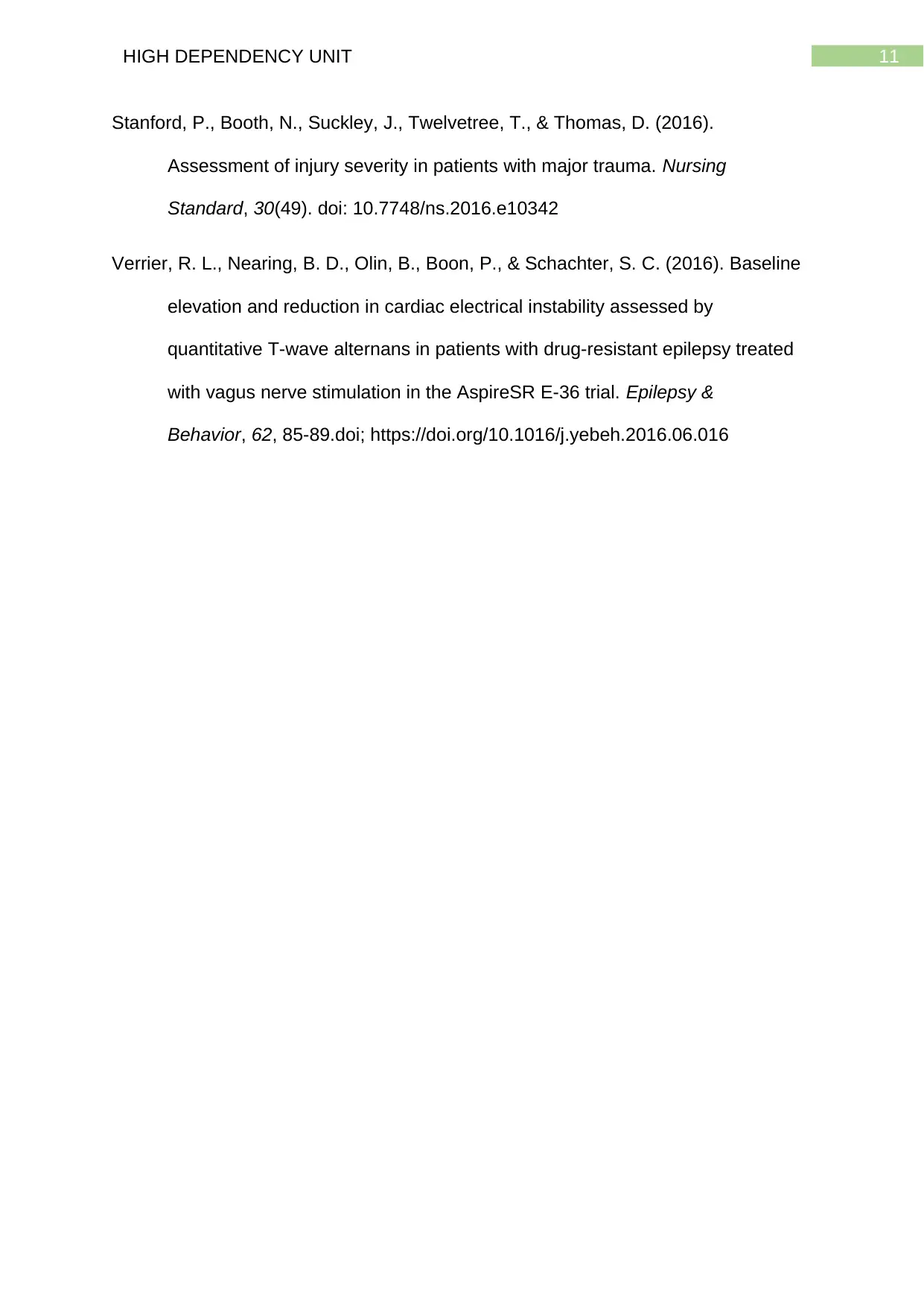
11HIGH DEPENDENCY UNIT
Stanford, P., Booth, N., Suckley, J., Twelvetree, T., & Thomas, D. (2016).
Assessment of injury severity in patients with major trauma. Nursing
Standard, 30(49). doi: 10.7748/ns.2016.e10342
Verrier, R. L., Nearing, B. D., Olin, B., Boon, P., & Schachter, S. C. (2016). Baseline
elevation and reduction in cardiac electrical instability assessed by
quantitative T-wave alternans in patients with drug-resistant epilepsy treated
with vagus nerve stimulation in the AspireSR E-36 trial. Epilepsy &
Behavior, 62, 85-89.doi; https://doi.org/10.1016/j.yebeh.2016.06.016
Stanford, P., Booth, N., Suckley, J., Twelvetree, T., & Thomas, D. (2016).
Assessment of injury severity in patients with major trauma. Nursing
Standard, 30(49). doi: 10.7748/ns.2016.e10342
Verrier, R. L., Nearing, B. D., Olin, B., Boon, P., & Schachter, S. C. (2016). Baseline
elevation and reduction in cardiac electrical instability assessed by
quantitative T-wave alternans in patients with drug-resistant epilepsy treated
with vagus nerve stimulation in the AspireSR E-36 trial. Epilepsy &
Behavior, 62, 85-89.doi; https://doi.org/10.1016/j.yebeh.2016.06.016
⊘ This is a preview!⊘
Do you want full access?
Subscribe today to unlock all pages.

Trusted by 1+ million students worldwide
1 out of 12
Related Documents
Your All-in-One AI-Powered Toolkit for Academic Success.
+13062052269
info@desklib.com
Available 24*7 on WhatsApp / Email
![[object Object]](/_next/static/media/star-bottom.7253800d.svg)
Unlock your academic potential
Copyright © 2020–2025 A2Z Services. All Rights Reserved. Developed and managed by ZUCOL.





